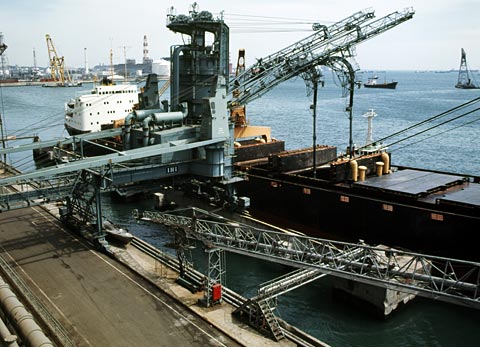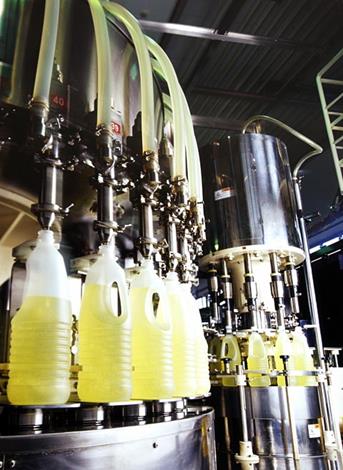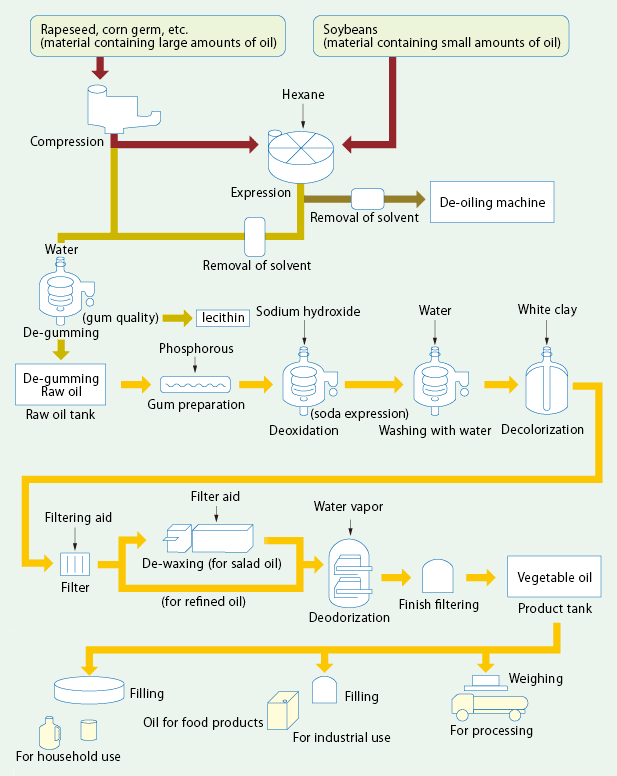Until now, we have explained global conditions for oilseeds and vegetable oil. Next, we will discuss conditions in Japan.
The vegetable oil manufacturing industry consists of expressing oil from raw materials such as oilseeds, separating the product into oil and meal, and then supplying each product to purchasers. Until now, the industry was referred to using the terms "oil expression" or "oil expression industry." However, a precise definition is necessary in order to avoid confusion. Vegetable oil is provided to consumers after passing through the manufacturing processes of transporting oil seeds, etc., expressing to extract oil from the raw materials, refining into edible oil, filling of containers, and shipping as a product.
Now, let's take a look at these processes in order.
1. Transporting oil seeds, etc.
In Japan, the manufacturing process starts with the arrival of oilseeds at ports. Soybeans, rapeseeds, and other oilseeds which are processed in bulk arrive at ports in large ships from the exporting country and dock next to adjacent expressing plants. The oilseeds are then loaded directly into an attached silo. The photograph in Figure 15 shows oilseeds being loaded from the docked ship into a silo. This process is called "unloading." In the case of expression plants which are located inland, oilseeds are first unloaded into a commercial silo at the port and are then transported to the inland expression plants by truck.
Figure 15: Unloading of oilseeds

On the other hand, oilseeds that are processed in small amounts (sesame seeds, etc.) are normally transported in containers instead of on large ships. These oilseeds are transported to expression plants on container trucks from the container yard of the port.
Also, rice bran and corn germ are generated at rice mills and starch plants. The quality of these products deteriorates quickly. Therefore, oil-manufacturing corporations collect and transport these products to expression plants as soon as possible.
Oil which is not expressed domestically in Japan (palm oil, sunflower oil, safflower oil, etc.) is mainly transported in special ships for crude oil (in the case of palm oil, the main product is a refined oil called "RBD") and stored in tanks.
2. Expression process
Expression is the process of using compression or solvent extraction to extract oil from raw materials such as soybeans, rapeseeds, and sesame seeds, and then separating the production into oil and meal. Compression is used for rapeseeds, sesame seeds, and other raw materials which contains large amounts of oil. However, a large amount of oil still remains in the raw materials after compression, so further oil is extracted using solvent extraction. Conversely, compression cannot be used to express oil from soybeans and other materials which only contain a small amount of oil. Therefore, solvent extraction is used initially for these oilseeds. The oil manufactured in this process contains a large amount of fatty/oily impurities and suspended solids, so it is called "crude oil." After removal of suspended solids and, in some cases, removal of free fatty acids from the crude oil, the resulting product is sometimes called "raw oil." This raw oil is stored in a tank. Also, the separated meal is prepared (drying, crushing, etc.) and stored in warehouses. The majority of vegetable oil traded internationally is crude oil. The soybean oil prices formed on CBOT are prices for crude oil.
3. Refining process
The crude oil stored in tanks is transported to the refining process. Manufacturing crude oil and imported crude oil contains large amounts of impurities, is very cloudy, and has a strong odor. Refining is a process for removing the suspend impurities (degumming), removal of free fatty acids (deoxidation), removal of color (decoloring), and removal of odor (deodorization). Oil that has passed through these processes is refined oil. Furthermore, salad oil is oil from which naturally occurring wax components have been removed. In a broad sense, salad oil is one type of refined oil. Vegetable oil fit for consumption is manufactured through these processes and stored in tanks.
Olive oil and sesame oil differ from soybean oil, etc., because they possess an inherently unique aroma and color that is pleasing to consumers. Therefore, although suspended solids are removed from these oils, they are not refined any further. Main examples are virgin olive oil and roasted sesame oil.
4. Filling and shipping
Refined oil (salad oil) that has been stored in tanks is filled into bottles for household consumption and 18-liter cans which are mainly used at restaurants, etc. The containers are then shipped to wholesalers, retailers, restaurants, and other customers. Oil intended for use in food processing is not filled into containers; instead, it is delivered to purchasers via tankers. Figure 16 shows salad oil being filled in bottles.
Figure 16: Bottles being filled with salad oil

The processes listed above are summarized in Figure 17. The vegetable oil-manufacturing industry can be called a "pipe industry." From the stage of transporting oilseeds from silos to expression plants until the manufacturing of the finished product, all processing is performed in a hermetically-sealed state. Oil is manufactured while flowing through pipes. Therefore, the only processes which can be visually observed by human workers are the initial unloading of oilseeds and the filling of the finished product into containers.
Figure 17: Until the production of vegetable oil

5. Characteristics of the vegetable oil manufacturing industry in Japan
As shown in the figure above, vegetable oil manufacturing has completely different processes for the expression process and the refining process. In the United States and other countries which produce large amounts of oilseeds, expression plants are located in oilseed production regions and collection regions and specialize solely on the expression process, thus enabling efficient production of crude oil. On the other hand, refining plants are located in areas close to consumption regions. Normally, crude oil is purchased from expression plants and then refined.
In Japan, the collection regions for raw materials (ports for imports) are located close to the consumption region. Therefore, it is normal for two types of plants to be located on the same premises. Accordingly, when visiting these plants, there is the illusion that soybeans and rapeseeds which were carried from a silo to the expression plant have been processed into the finished product of refined oil (salad oil). However, this is not the case. In actuality, crude oil is manufactured from oilseeds such as soybeans and rapeseeds, and then stored. Then, the final product is manufactured from this crude oil. Although there is the common misconception that edible oil is a primary product, it is actually a secondary product as explained here.
The vegetable oil manufacturing industry is also called the "manufactured oil business" and the "manufactured oil industry." As explained above, Japanese oil-manufacturing corporations normally possess both expression plants and refining plants. However, some corporations and plants only perform one of the processes. Historically, the modern vegetable oil manufacturing industry in Japan grew based on the raw materials of domestic rapeseed and soybeans produced in Manchuria (a region in northeast China). Today, rice bran is the only domestic raw material used on a commercial base. Japan depends almost entirely on imports of raw materials (oilseeds). As regional industry, vegetable is produced from small amounts of domestic rapeseed, peanuts, etc. However, when the weight does not reach 1,000 tons, these amounts are counted as "0" in domestic statistics.




